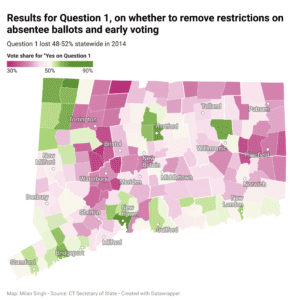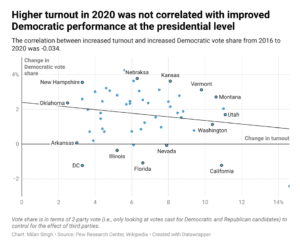Early voting is safe, convenient, and nonpartisan — it’s a commonsense reform we need.
In five weeks, voters across the United States will go to the polls to choose their governors, senators and members of Congress. Here in Connecticut, something else is also on the ballot: a referendum to remove the constitutional ban on in-person early voting.
During the 2021-2022 legislative session, a bipartisan majority of lawmakers in Hartford voted to put forth a state constitutional amendment. The proposed amendment would change the text of Articles III, IV, and VI of the Connecticut Constitution to give the state government the option to pass a law implementing in-person early voting.
In 2014, Connecticut voters voted 48-52 to reject Question 1, a similar constitutional amendment that would have given the legislature permission to remove restrictions on in-person early voting and expand access to absentee (i.e., mail-in) ballots.

It is likely that many who voted “no” in 2014 still have their doubts about early voting — so let me do my best to convince skeptical readers to vote “yes” this time around.
Early voting is the norm for most of the country — in red and blue states alike. According to the National Conference of State Legislatures, an organization of state legislators, Connecticut is one of only four states (the others being Mississippi, Alabama and New Hampshire) to offer no early voting options. If ruby-red West Virginia and navy-blue Vermont can agree on a policy, it seems like a no-brainer for Connecticut voters.
Voters may be concerned about the difficulty of expanding voting hours and the strain it puts on election workers. But as a former poll worker, I can promise you that it’s not a burden. Spreading out voters across multiple days reduces the risk of long lines and jam-packed poll booths.
But might early voting give one political party an advantage in elections? A 2020 paper by Kaplan & Yuan looked at a 2010 Ohio law that forced counties to standardize their early voting windows and found a 0.22 percentage point increase in voter turnout for every additional day of early voting, with “greater impacts on women, Democrats, independents, and those of child-bearing and working age.” But a 2017 study by Burden et al. came to the opposite conclusion, finding that “contrary to conventional wisdom, the results show that early voting generally helps Republicans.”
If you prefer real-world examples over academic research, then consider the 2020 election: due to Covid-19, many states expanded their early and absentee voting options. Turnout for the presidential election was 66.8% of eligible voters, the highest since 1900. A record 35.8 million ballots were cast early in person, making up more than one in five of all ballots cast.
When I compared state-by-state data for the last two presidential elections, I found no correlation between increased turnout and higher Democratic vote share. In other words, expanded early voting options did lead to higher turnout, but did not give an edge to Democrats. The overall partisan effect was more or less a wash, if anything there was a very small correlation between turnout and higher Republican vote share.

At the end of the day, this referendum is about choice. If you prefer to vote on Election Day, then you’re more than free to continue doing so. But if you’ve already set your mind on who to vote for, can’t get off work on a Tuesday, or just want to beat the crowd, early voting gives you the freedom to cast your ballot whenever is most convenient for you.
On Nov. 8, I plan to vote “yes” on Question 1. I hope you will, too.
MILAN SINGH is a first year in Pierson College. Contact him at milan.singh@yale.edu.







